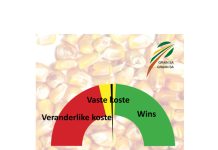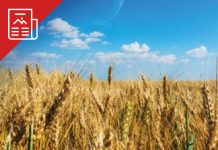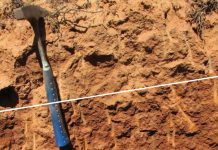Soil is the most fundamental resource for the farmer, without which food and natural fibre cannot be produced. This article forms part of a series to highlight this resource.
Soil degradation (deterioration of soil properties) is one of the most important aspects that influence global food security. Sustainable agriculture focuses, inter alia, on the protection of the ability of soil to continually support plant growth.
This article forms part of a series to highlight this resource, and the next few articles will focus on soil degradation (Figure 1). It is these properties that every producer must manage and protect, because they are fundamental to every farming operation. After all, we are borrowing the soil on which we farm today, from our children and we must give the soil back to them so that they, like us, have a chance to make a living on it.
Throughout the world one finds soil that has degraded to such an extent that one can no longer farm on it and it is then abandoned. “New” soil is then deforested and cropped for a number of years until it also becomes unproductive and is also abandoned.
With the growing world population, something like this should never happen – and one cannot afford to let it. The production ability of soil must be maintained so that it remains productive forever.
Soil properties are divided into three broad groups, namely physical, chemical and biological – each with its own set of properties. In the previous issues, the scientific basis of the majority of these properties were discussed.
The soil properties that are sensitive to degradation, and ways to counteract soil degradation, are discussed in the following issues. They should enable the producer to improve the sustainability of his farming operation.
Physical properties of soil that tend to degrade
Texture and mineralogical composition
Soil texture refers to the ratio of sand, silt and clay to each other (Part 5 of this series). Soil texture is generally regarded as a reasonably fixed property, but it can be changed by erosion.
During wind and water erosion, the finer soil particles (mainly clay, silt and humus) are carried away in suspension and deposited elsewhere. The effect of this is that the soil from where the particles were eroded, becomes sandier, and the soil where it was deposited becomes more clayey. The nutritional value of the soil lies exactly in the clay and humus, and erosion makes soil quality poorer.
Silt, clay and humus play a fundamental role in the hydraulic properties of the soil. It is particularly the water retention ability and capillary movement that are controlled by the finer soil particles.
Wind and water erosion and the control thereof will be broadly discussed in the following articles.
Structure
Soil structure refers to the aggregation of individual soil particles to form larger structural units (small clods). Stability of structure is important so that the structural units do not disperse (dissolve) when rain falls on them.
Various factors contribute to this (Part 6 in this series). It is especially when soil is turned over in residue-free systems, when the land lies “red”, that the natural water stable structure is degraded and surface sealing becomes a further degradation factor. The effect of this is that the soil is exposed to wind and water erosion, which then leads to further soil degradation.
Surface crusting per se is also regarded as an important degradation factor because it is detrimental to gas exchange (the inward movement of oxygen and the outward movement of carbon dioxide). It is also seriously detrimental to water infiltration, as the pores at the soil surface become silted up.
Stable water structure at the surface of the soil is of importance to the producer. To achieve this, the management of organic material and the humus content is also of major importance. Crop residues should rather be left lying on the soil surface, so that the microbe activity which is responsible for the stable water aggregate, may be stimulated.
In this way, crust formation is limited, with the result that water infiltration (especially after heavy thunderstorms) is increased greatly. Water that infiltrates, cannot cause water erosion and it leads to increased production. Stable structure at the soil surface also prevents wind erosion as the aggregates are too heavy to be carried away by wind.
The advantage of conservation tilling systems is that they must promote and maintain the stable water structure.
Bulk density and porosity
Bulk density refers to the soil’s mass per volume. When soil is compacted through tractor and land traffic, the bulk density of the soil increases while the porosity (pores as a percentage of the soil volume) is decreased.
Soil therefore offers greater resistance to deformation and plant roots need greater effort to displace soil particles when they grow through the soil, up to the point where the resistance is too high and the plant root cannot grow any further.
Compaction or the increase in bulk density is an important degradation factor in crop production and is responsible for major crop losses because it seriously stunts root growth and development. Compaction may be effectively controlled by traffic control systems. When compaction does occur, it must be lifted by deep ripping.
Laterisation
Laterite (hard plinthite) in the soil is caused by the process of alternating, intense wetting and drying. However, this is a very long process (covering centuries, rather millennia). Cases are well-known where deeply drained red soil yellowed under years of irrigation and even also formed soft plinthite. Theoretically it is now also possible that laterite may be able to form in these profiles, which could degrade the cropping potential of the soil.
Physical pollution
In some areas, physical pollution is a problem because plastic, scrap metal and rubbish is left in and on the soil. This can greatly restrict land use.
Physical removal or coverage
Topsoil is often removed through mining, engineering construction, town development or other forms of development. Or it is sometimes covered. This is almost always very drastic and can only be recovered or rehabilitated at great cost.
Chemical properties of soil that tend to degrade
Reduction of fertility
Soil fertility is defined as the soil condition where the macro and micro nutrients are provided in adequate quantities and in the correct balance for the growth of specific plants.
The degradation of humus is regarded, inter alia, as a reduction in fertility. Humus makes a major contribution to the soil’s cation exchange capacity (CEC), which provides the soil with the ability to adsorb plant nutritional substances in the form of basic cations (K+, Ca2+, Mg2+ and NH3+) and in turn to provide them to the growing plant.
When soil is physically disturbed, especially when it is turned over and aerated in residue-free operations using a mouldboard plough, large quantities of humus are mineralised (converted to plant nutrients). In so doing, after about ten years, sandy soils only have half of their original humus levels left.
The maintenance of humus levels is of major value. Reduced and no-till systems are the only way to effectively combat this degradation on a large scale. As soon as organic material is inverted into the soil, it is mineralised and then contributes very little to the building up of humus levels. Almost all the micro-elements are bound by organic material and released to growing plants via mineralisation.
When the removal of the above-mentioned basic cations exceeds the supplementation thereof (nett loss), the fertility of the soil is degraded. Farming practice must be focused on maintaining these levels and even improving them. The effect of organic material was discussed in greater detail in articles 14 to 17 in this series.
Chemical imbalances
Acidification
Acidification takes place when the basic cations (K+, Ca2+, Mg2+ and NH3+) are replaced by acidic cations (H+ and Al3+). The percentage of the exchange complex which is filled with acidic cations, is known as acid saturation. Nitrogen fertilisers contribute the most towards the addition of H+, while growing plants and rotting plant material also make a contribution as basic cations are removed (Acidification was discussed in greater detail in Part 8). In the eastern Highveld, the burning of coal for the provision of electricity emits large quantities of acid into the air which end up on the soil as acid rain.
Acidification can be combatted by regularly adding large amounts of lime to the soil. Lime provides Ca2+ and Mg2+ as basic cations and as plant nutrition. The CO3 portion reacts with H+ to form H2O and CO2.
Soil becoming brackish
Soil becomes brackish when an excess of Na+ is adsorbed on the exchange complex (>15%) or when there are too many salts present in the soil solution. Brackishness was discussed in greater detail in Part 18.
Pollution
In agriculture, the use of agricultural chemical substances is a source of poisons. These days, the majority of them are degradable and, as a result, do not remain active in the soil for long. By-products of mining activities are especially a major problem in terms of chemical pollution. The above-mentioned acid rain is also a form of chemical pollution.
Biological soil properties that tend to degrade
Organic material and humus
Non-humicated organic material and humus play a major role in a variety of physical, chemical and biological soil properties (Parts 14 to 17). Maintenance of optimal organic levels is, for that reason, of major importance. Soil tillage and overgrazing of veld are the main causes of the degradation of organic material in soil.
Soil fauna and flora
Healthy and diverse populations of fauna and flora are important for the producer. Soil life controls a variety of chemical processes without which higher life forms on earth could not exist. Of these, the breaking down and circulation of plant and animal residues are the most important, otherwise earth would eventually become unliveable. Furthermore, they are also responsible for the breaking down of pollution products caused by human activities.
From an agricultural point of view, the addition of herbicides and insecticides are of major importance for the soil. These chemicals are designed to kill plant and animal life selectively. In doing so, they have an effect on the soil fauna and flora.
Because the majority of herbicides and insecticides used today are selective, the effect thereof on the soil fauna and flora is also selective. This results in, for example, that when predatory mites are killed, the populations of the organisms that they live upon, increase sharply and may become a plague for the producer. Nematodes are hardly influenced by herbicides and insecticides.
Producers should follow the golden mean: Use herbicides and insecticides within registration, according to the instructions and only when necessary. Fumigators and nematocides generally have a very negative effect on soil life and should only be used with great caution. Crop rotation, which especially includes leguminous plants, is the most sustainable way to stimulate a diverse soil life.
Increase in pathogens
Monoculture systems are the primary cause of the build-up of pathogenic populations, to levels where they become problematic for the producer. The principle here is that the same crop every year provides excessive nutrition for those organisms that feed upon it. Their populations increase continually, while those organisms that must inhibit the pathogenic populations, often do not get suitable nutrition. The result is an imbalance between population groups and species composition.
In order to manage these imbalances, a healthy crop rotation system is important.
Summary
Soil degradation is a very important factor which threatens the sustained production of healthy and safe food for mankind in the long term. Producers should set up farming practices so that the degradation of soil properties is reduced. Sustainable land use focuses on the simultaneous management of physical, chemical and biological degradation factors. They have a direct influence on the sustainability of each and every farming system.
For further information, please contact the authors on:
Martiens du Plessis: 072 285 5414 / martiens@nwk.co.za or Prof Cornie van Huyssteen:
vanhuyssteencw@ufs.ac.za.
REFERENCES
- Allison, F.E. 1973. Soil organic material and its role in crop production. Elsevier Scientific Publishing Company, New York.
- Brady, N.C. 1990. The nature and properties of soils. 10th ed.
Macmillan Publishing Company, New York. - Van der Walt, H.V.H. & Van Rooyen, T.H., 1990. A glossary of soil science. The Soil Science Society of South Africa, Pretoria.

















